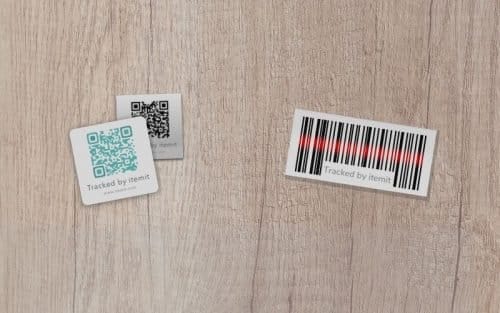
Asset stickers help you monitor your business’ critical equipment. You can use them for tools and equipment tracking, IT asset management, fixed asset tracking, and more.
They are physical stickers that you can stick onto your assets. They contain a unique code, and you can scan this code into your asset tracking software.

How Do Asset Tags Work?
Another name for asset stickers is asset tags. Asset tags are used in all manner of asset tracking operations to speed up asset monitoring and to increase accountability.
If you’re well versed in using a spreadsheet for your asset tracking operations, you’ll already know the gaps. Onsite audits are lengthy and unwieldy as you need to record any changes onsite, then update your asset register later.
Even with asset tracking software, you need to perform searches on your assets when you’re on-site to ensure that you’re updating the correct records.
Asset tags remove the need for this as, now, you’ll be able to scan a tag to retrieve the correct records, ready for speedy and accurate updates to your data.
How To Use Asset Stickers
Using asset stickers is simple. First of all, you can create an asset register in your asset tracking software. This will contain your asset information and records.
For example, if you’re using the system for construction equipment tracking, you’ll be able to log each spanner, tool, drill, and all of your heavy equipment. Each of these assets will have a unique profile.
Then, you’ll be able to stick your asset stickers onto your equipment and scan them into your asset tracking app. As the sticker contains unique information, it links to a unique asset profile.
What this means is that now, every time you scan the asset’s sticker, it will retrieve the corresponding assets’ profile on your asset tracking app, ready for you to add issues, information, or view attachments.
Other Uses
Not only do asset tags speed up your asset discovery process, but you can also use them for bulk actions. As each tag contains a unique ID that’s associated with each tag, you can scan a number of assets at speed.
This means that you can run asset audits when you’re in a location to double-check all of your assets are accounted for. All you need to do is press an audit feature in your asset tracking app and scan the tags.
You can also move assets between locations in bulk. Again, you simply need to scan all of the tags into the new location to update your records.
Every scan also updates the assets’ last seen location and the user who scanned the tag, as well as the user who scanned it. Therefore, if there’s an issue reported against your assets, you’ll be able to pinpoint who reported this issue and where, speeding up maintenance.
All of the data you update within your app also updates online, meaning you’ll be able to run helpful reports on the information you’re gathering. This saves you money as you’ll create robust records that you can use as a fixed asset register in the process.
Types Of Asset Tag
You can customise your asset stickers, too. This means that you’re not confined to vinyl tags where standard stickers may not be appropriate.
For example, if you have heavy tools and equipment that go through consistent weathering, you’ll be able to use metal QR tags. These tags are much more durable and will survive harsher environments.
You can also customise asset stickers so that they contain your company’s branding. This may add a personalised touch, but it also serves as an instant indicator of which assets belong to your company if you’re hiring them out or sharing them with other businesses.
To find out more about itemit and how you can use asset stickers for your asset management, you’ll be able to contact the team at team@itemit.com. You can also fill in the form below to start your 14-day free trial. you can even use your own asset stickers!

Try itemit
Choose a better way to track
your assets.
Start your free 14-day trial now!

Keep Learning
itemit Blog
Tips, guides, industry best practices, and news.
What Is Active RFID? A Complete Guide to Smart RFID Tags
Discover what Active RFID is, how active tags function, and the key benefits and use cases that make this technology essential for modern tracking systems.
Everything You Need to Know About 2D Barcodes
Discover everything about 2D barcodes, including how they work, their benefits, and how they are revolutionizing industries and improving business operations
Complete Guide to Asset Lifecycle Management and Its Benefits
Learn about asset lifecycle management and how it helps businesses optimize asset usage, reduce costs, and improve efficiency throughout the asset’s life.



